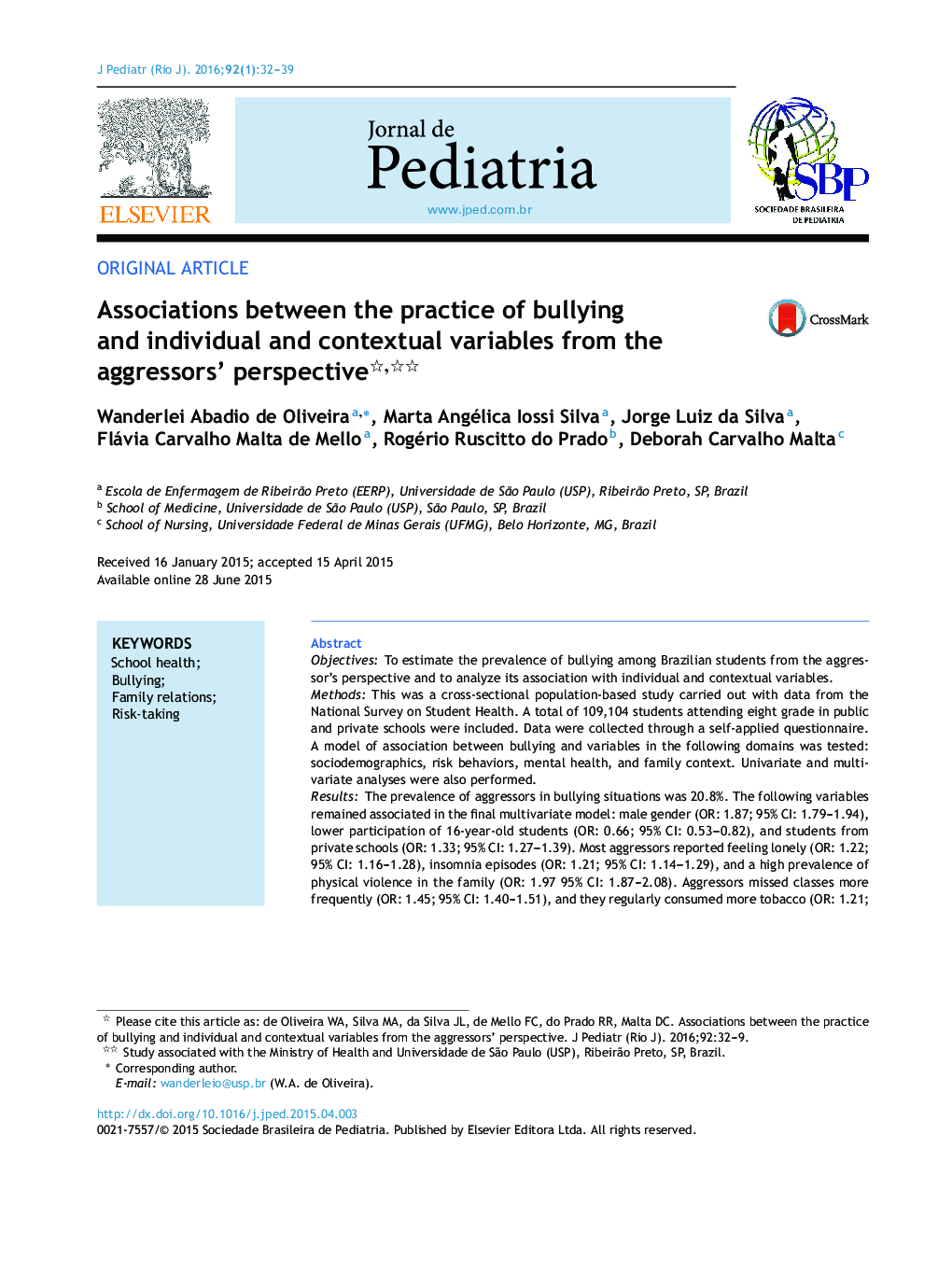| Article ID | Journal | Published Year | Pages | File Type |
|---|---|---|---|---|
| 4153880 | Jornal de Pediatria | 2016 | 8 Pages |
ObjectivesTo estimate the prevalence of bullying among Brazilian students from the aggressor's perspective and to analyze its association with individual and contextual variables.MethodsThis was a cross-sectional population-based study carried out with data from the National Survey on Student Health. A total of 109,104 students attending eight grade in public and private schools were included. Data were collected through a self-applied questionnaire. A model of association between bullying and variables in the following domains was tested: sociodemographics, risk behaviors, mental health, and family context. Univariate and multivariate analyses were also performed.ResultsThe prevalence of aggressors in bullying situations was 20.8%. The following variables remained associated in the final multivariate model: male gender (OR: 1.87; 95% CI: 1.79–1.94), lower participation of 16-year-old students (OR: 0.66; 95% CI: 0.53–0.82), and students from private schools (OR: 1.33; 95% CI: 1.27–1.39). Most aggressors reported feeling lonely (OR: 1.22; 95% CI: 1.16–1.28), insomnia episodes (OR: 1.21; 95% CI: 1.14–1.29), and a high prevalence of physical violence in the family (OR: 1.97 95% CI: 1.87–2.08). Aggressors missed classes more frequently (OR: 1.45; 95% CI: 1.40–1.51), and they regularly consumed more tobacco (OR: 1.21; 95% CI: 1.12–1.31), alcohol (OR: 1.85; 95% CI: 1.77–1.92), and illegal drugs (OR: 1.91; 95% CI: 1.79–2.04); they also demonstrated increased sexual intercourse (OR: 1.49 95% CI: 1.43–1.55) and regular exercise (OR: 1.20; 95% CI: 1.16–1.25).ConclusionsThe data indicate that bullying is an important aspect that affects the learning-teaching process and the students’ health.
ResumoObjetivosEstimar a prevalência de bullying, sob a perspectiva do agressor, em escolares brasileiros, e analisar sua associação com variáveis individuais e de contexto.MétodosEstudo transversal, de base populacional, com dados da Pesquisa Nacional de Saúde do Escolar. Participaram 109.104 estudantes do 9° ano do Ensino Fundamental de escolas públicas e privadas. A coleta de dados ocorreu por meio de um questionário autoaplicável. Foi testado modelo de associação entre o bullying e variáveis nos seguintes domínios: sociodemográfico, comportamentos de risco, saúde mental e contexto familiar, bem como realizadas analises uni e multivariada.ResultadosA prevalência de agressores em situações de bullying foi de 20,8%. No modelo final multivariado permaneceram as seguintes variáveis associadas: sexo masculino (OR: 1,87; IC 95%: 1,79-1,94), menor participação de escolares de 16 anos (OR: 0,66; IC 95%: 0,53-0,82), estudantes de escola privada (OR 1,33 IC95% 1,27-1,39). A maioria dos agressores relatou se sentir solitário (OR: 1,22; IC 95%: 1,16-1,28), com episódios de insônia (OR: 1,21; IC 95%: 1,14-1,29) e alta prevalência de sofrer violência física familiar (OR: 1,97 IC 95%: 1,87-2,08). Os agressores faltam mais às aulas (OR: 1,45; IC 95%: 1,40-1,51), consomem regularmente mais tabaco (OR: 1,21; IC 95%: 1,12-1,31), álcool (OR: 1,85; IC 95%: 1,77-1,92) e drogas ilícitas (OR: 1,91; IC 95%: 1,79-2,04), tem relação sexual OR: 1,49 IC95% 1,43-1,55) e praticam atividade física regular (OR1,20 IC95% 1,16-1,25).ConclusõesOs dados indicam que a prática do bullying é aspecto relevante que interfere no processo ensino-aprendizagem e na saúde dos escolares.
